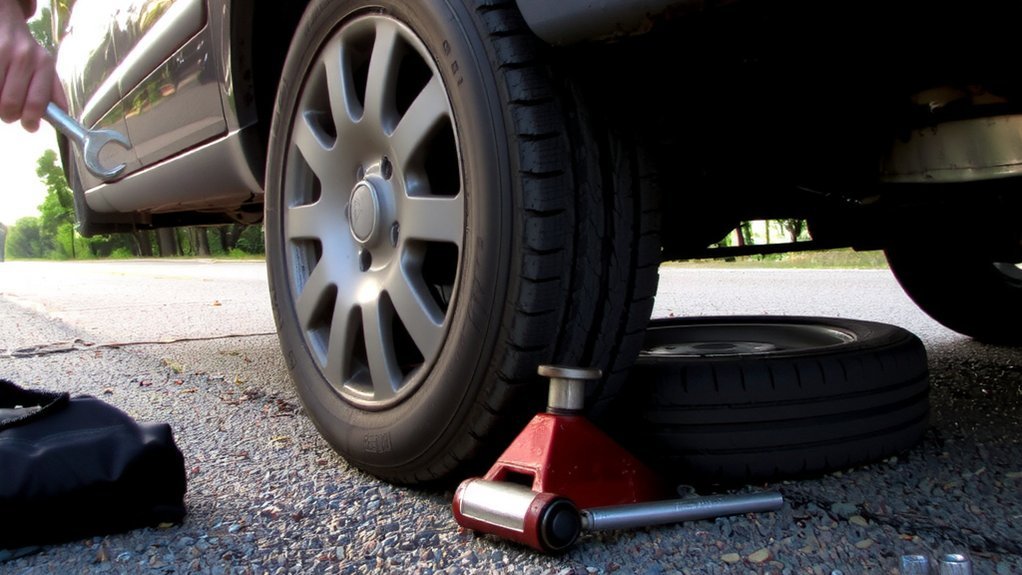You’ll want to stay calm and act deliberately when you get a flat. Pull over to a level, well-lit spot and set the parking brake. Don’t stand in traffic or trust an unstable jack. You’ll get step-by-step actions to get back on the road safely — starting with where to stop.
Preparing the Vehicle for a Tire Change
Pulling over to a level, well-lit area keeps you safe.
Park off the road, set the parking brake, and put the transmission in park or first gear.
Turn on your hazard lights and, if you have them, use roadside triangles or flares a safe distance behind the car.
Place wheel chocks or large rocks against the opposite wheel to prevent rolling.
Grab your owner’s manual, spare, jack, and lug wrench from the trunk so you won’t search in the cold.
Wear gloves and a reflective vest if you have one.
Locate the jack points near the wheel well and note the spare’s mounting method.
Stay aware of traffic, and call for help if you feel unsafe.
Keep your phone charged and emergency contacts ready.
Loosening the Lug Nuts Correctly
Start by breaking the lug nuts loose while the car is still on the ground so the wheel won’t spin.
Use the correct socket and a sturdy wrench or breaker bar. Fit the tool fully onto each nut to avoid rounding.
Turn counterclockwise with steady, controlled force; brace the wrench and use your body weight if needed. Loosen nuts in a star or crisscross sequence to relieve pressure evenly.
Back each nut off several turns, but don’t remove them completely until the wheel is supported. If a nut’s stuck, apply penetrating oil, let it soak, then try again.
Keep the loosened nuts together in a small container so none roll away or get lost. Wear gloves and eye protection to help prevent hand injuries.
Raising the Vehicle Safely
Before you lift the car, make sure it’s on firm, level ground, the parking brake’s set, and the opposite wheel is chocked;
then position the jack under the vehicle’s designated jacking point (check your owner’s manual) and pump it until the tire just clears the ground.
Keep your body clear of the jack path and never place any part of your body under the vehicle while it’s supported only by the jack.
Once raised to the needed height, set at least one rated jack stand under a solid support point, slowly lower the jack until the vehicle rests on the stand, and give the car a gentle push to confirm stability.
If you have a wheel wedge or chock, use it for extra security.
Removing the Flat Tire
Once the vehicle’s securely supported, pry off any hubcap and break the lug nuts loose with your wrench—turn counterclockwise—then remove the nuts and keep them in a safe spot.
Grip the tire at 3 and 9 o’clock, then pull straight outward to dislodge it from the hub; if it’s stuck, tap the tire’s sidewall with the heel of your hand or use a rubber mallet on the back of the tire to free it.
Lift using your legs, not your back, and set the flat down away from traffic.
Inspect the wheel hub and brake components for obvious damage or debris.
Place the flat where you can access the valve stem to confirm it’s punctured before disposal or repair.
Wear gloves to protect yourself.
Installing the Spare Tire
Lift the spare onto the hub, aligning the wheel holes with the studs and pushing it flush against the rotor; then hand-thread the lug nuts to hold it in place.
Use the star or crisscross tightening pattern: snug each nut sequentially in opposing order to center the wheel. Tighten them by hand until they’re finger-tight, then use the lug wrench to increase resistance in the same pattern, avoiding full-force turns on a single nut.
If you have a torque wrench, set it to the manufacturer’s specification and apply final torque once the vehicle’s weight is supported. Replace and stow the flat, tools, and jack. Recheck lug nut tightness after a short road drive per your owner’s manual. Note the repair and inspect spare soon.
Lowering the Vehicle and Final Checks
After you’ve snugged the lug nuts, lower the jack slowly until the wheel contacts the ground and the vehicle’s full weight rests on it—keep your hands and feet clear while you do this.
Once it’s down, finish tightening the lug nuts in a star pattern to the manufacturer’s torque rating if you have a torque wrench; if not, tighten evenly.
Remove the jack and stow tools and the flat tire.
Check tire pressure on the spare and inflate if needed to the recommended PSI.
Inspect the spare for damage and confirm the valve cap is on.
Recheck lug nuts after a short drive and get the damaged tire repaired or replaced promptly.
Immediately dispose or store the flat tire according to local regulations.
Conclusion
You’ve prepared the car, loosened lug nuts, raised and supported the vehicle, removed the flat, and installed the spare. Now lower the car, tighten and torque the lug nuts in the proper sequence, stow your tools, and check tire pressure and nearby traffic for safety. Drive cautiously to a repair shop to have the damaged tire inspected or replaced. Keep practicing these steps so you’ll feel confident if it happens again and avoid roadside panic.
